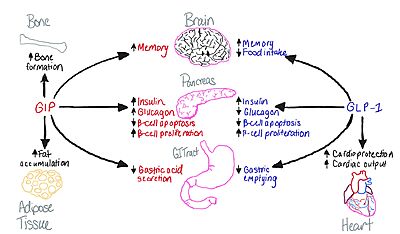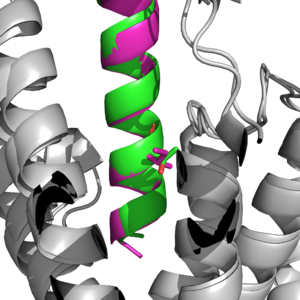User:SaraKathryn Kalkhoff/Sandbox 1
From Proteopedia
(Difference between revisions)
| Line 4: | Line 4: | ||
== Introduction == | == Introduction == | ||
[https://www.sciencedirect.com/topics/medicine-and-dentistry/gastric-inhibitory-polypeptide The Glucose-dependent Insulinotropic Polypeptide (GIP) is a ligand that can be bound to its receptor (GIP-R) to help facilitate the breakdown of glucose.] This is the basis of what makes up one of the key ways that glucose is bound and broken down into different parts, including insulin, to be able to maintain blood glucose levels within the body. With this structure, it is also to work with the GLP-1 receptors found within cells to help break down glucose present within cells to create energy. Unfortunately for many people with diabetes, they are unable to bring in as much glucose from the GLUT-1 transporter found within a cell and causes a higher blood glucose level that can become toxic if left untreated <ref name ='Seino'>DOI:10.1111/j.2040-1124.2010.00022.x</ref>. | [https://www.sciencedirect.com/topics/medicine-and-dentistry/gastric-inhibitory-polypeptide The Glucose-dependent Insulinotropic Polypeptide (GIP) is a ligand that can be bound to its receptor (GIP-R) to help facilitate the breakdown of glucose.] This is the basis of what makes up one of the key ways that glucose is bound and broken down into different parts, including insulin, to be able to maintain blood glucose levels within the body. With this structure, it is also to work with the GLP-1 receptors found within cells to help break down glucose present within cells to create energy. Unfortunately for many people with diabetes, they are unable to bring in as much glucose from the GLUT-1 transporter found within a cell and causes a higher blood glucose level that can become toxic if left untreated <ref name ='Seino'>DOI:10.1111/j.2040-1124.2010.00022.x</ref>. | ||
| - | [[Image:Gip glp.jpeg|400 px|right|thumb|Figure 1: Distinction of functions between the GIP and GLP-1 receptors.]] | + | [[Image:Gip glp.jpeg|400 px|right|thumb|Figure 1: Distinction of functions between the GIP and GLP-1 receptors.]] |
| + | ===History=== | ||
| + | This receptor was founded ? | ||
== Function == | == Function == | ||
The GIP receptor helps facilitate movement of glucose within a cell. <ref name='Sun'>PMID:35333651</ref>. It has a natural ligand that is 42 residues and helps kickstart the GIP-R into firing, as a transporter for glucose in and out of the cell. Once the levels become too high, the ligand will send this transporter back down into the cell and not have anymore glucose activate. It will also cause the insulin pathway to start to help signal that there is too much glucose in the body. As mentioned above, many issues that arise with diabetes can affect the rate of transport within these transporters for the cell. | The GIP receptor helps facilitate movement of glucose within a cell. <ref name='Sun'>PMID:35333651</ref>. It has a natural ligand that is 42 residues and helps kickstart the GIP-R into firing, as a transporter for glucose in and out of the cell. Once the levels become too high, the ligand will send this transporter back down into the cell and not have anymore glucose activate. It will also cause the insulin pathway to start to help signal that there is too much glucose in the body. As mentioned above, many issues that arise with diabetes can affect the rate of transport within these transporters for the cell. | ||
Revision as of 03:05, 24 April 2024
| |||||||||||


